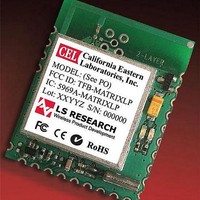ZMXM-400-1-B CEL, ZMXM-400-1-B Datasheet - Page 5

ZMXM-400-1-B
Manufacturer Part Number
ZMXM-400-1-B
Description
Zigbee / 802.15.4 Modules & Development Tools Matrix Zigbee 10mW 10MW Module
Manufacturer
CEL
Datasheet
1.ZMXM-400-KIT-2.pdf
(13 pages)
Specifications of ZMXM-400-1-B
Wireless Frequency
2405 MHz to 2480 MHz
Interface Type
UART
Operating Voltage
3.6 V
Output Power
100 mW
Antenna
PCB Trace
Operating Temperature Range
- 45 C to + 125 C
Lead Free Status / RoHS Status
Lead free / RoHS Compliant
ANTENNA
The Matrix module includes an integrated PCB trace antenna. An optional configuration with a MMCX connector is also
available. The module regulatory certification has been completed with the PCB trace antenna and also with a Nearson
(part# S131CL-5-RMM-2450S) dipole antenna on a 5 inch cable using the MMCX connection.
The integrated PCB antenna topology is an F-antenna. This antenna is used because it is reasonably compact, has a
fairly omni-directional radiation pattern, good efficiency, and is very simple. An adequate ground plane directly beneath the
module but not under the antenna is necessary to provide good efficiency.
The antenna radiation patterns are dependent upon the carrier board the Matrix module is placed upon. Measured
radiation patterns of the module alone are available by contacting LS Research.
The environment the module is placed in will dictate the range performance. The non-ideal characteristics of the
transmission channel result in the transmitted signal producing reflection, diffraction, and/or scattering. All of these factors
randomly combine to create extremely complex scenarios.
It is also best to keep some clearance between the antenna and nearby objects. This includes how the module is mounted
in the product enclosure. Unless the items on the following list of recommendations are met, the radiation pattern can be
heavily distorted.
POWER AMPLIFIER
Both variants of the Matrix modules contain a Power Amplifier. The Matrix 10 mW (ZMXM-400) has a maximum Power Out
of 10 mW, while the Matrix 100 mW has a maximum Power Out of 100 mW.
The Power Amplifier is controlled via the P1_2 General Purpose I/O (GPIO) of the Texas Instruments CC2430. As such, the
P1_2 GPIO needs to be configured as an output in the application source code to enable control the Power Amplifier.
When P1_2 drives LOW (i.e. logic level ‘0’) the Power Amplifier is disabled and maximum Power Out is 1 mW regardless
of module in use. When P1_2 drives HIGH (i.e. logic level ‘1’) the Power Amplifier is enabled and maximum Power Out is
either 10 mW or 100 mW depending upon which variant of the Matrix module is in use. Intermediate power level settings
(i.e. between 1 mW and 10 or 100 mW) may be achieved by enabling the power amplifier and then varying the Power Out
of the CC2430.
• Never place ground plane or copper trace routing underneath the antenna.
• Never place the antenna very close to metallic objects.
• In the final product, ensure that any wiring or other components do not get too close to the antenna.
• The antenna will need a reasonable ground plane area on the mother board area to be efficient.
• Do not use a metallic enclosure or metallized plastic for the antenna.
• Try to keep any plastic enclosure greater than 1 cm from the antenna in any orientation.
ZMXM-400 Series

















